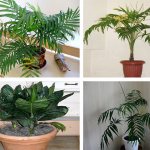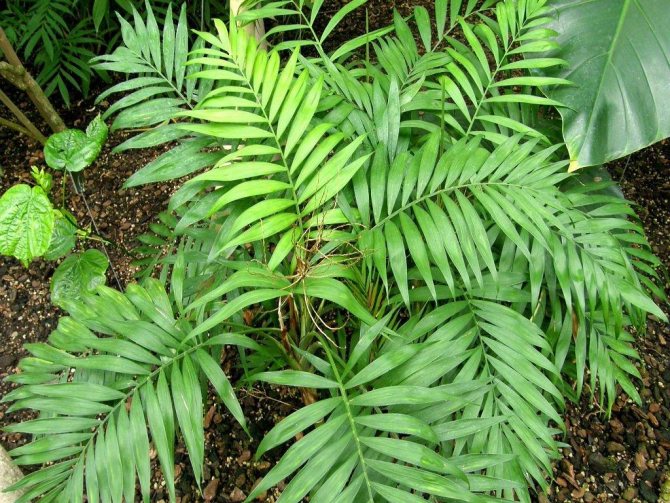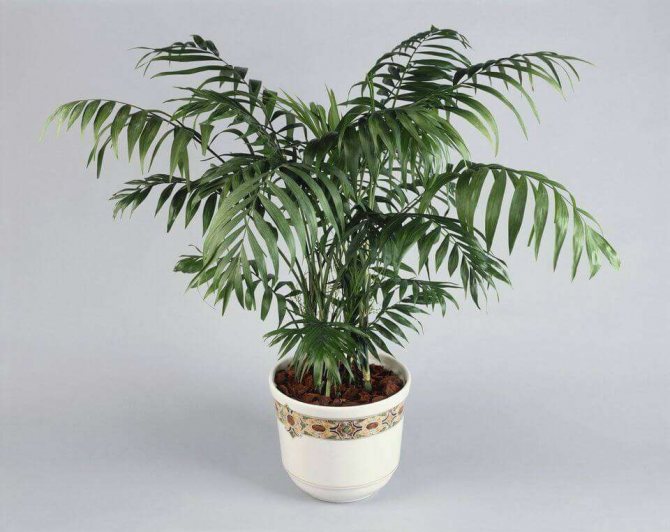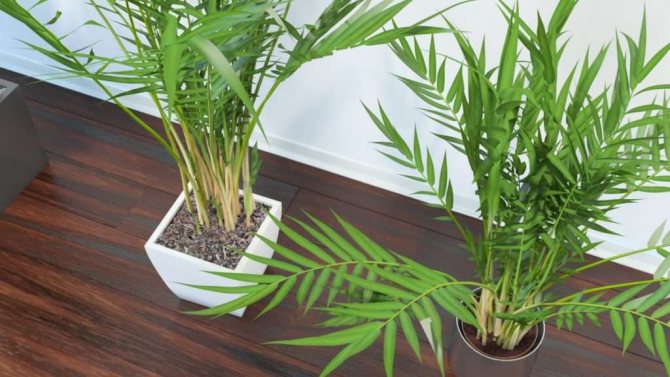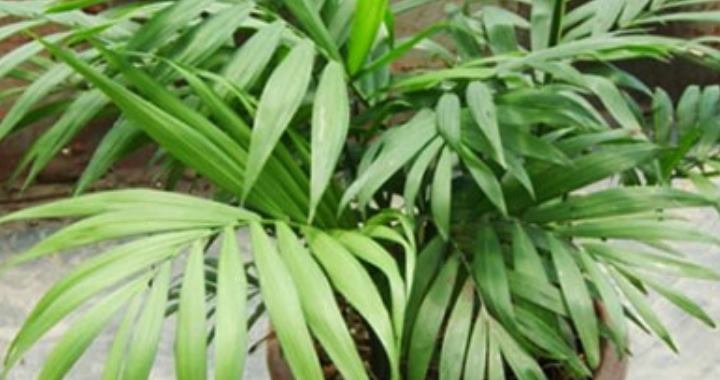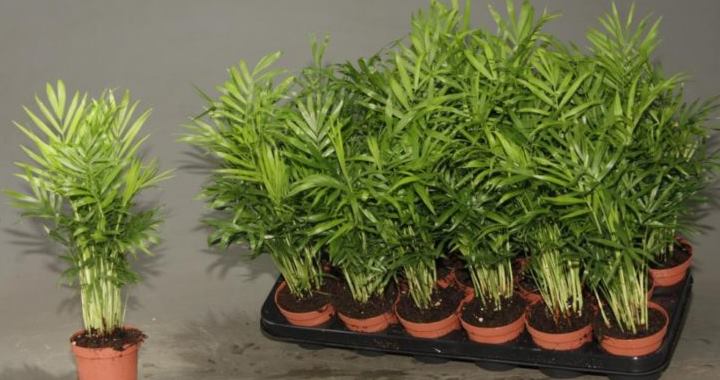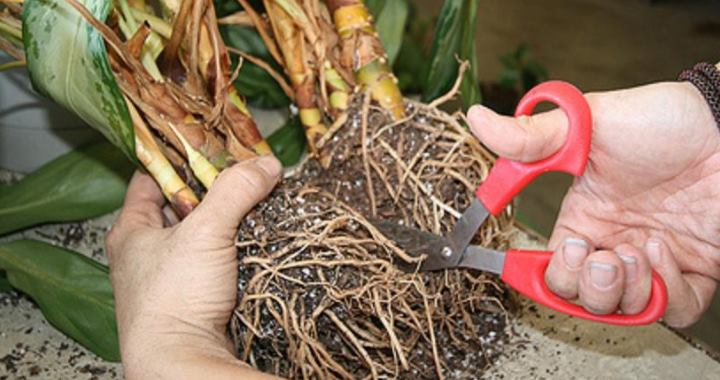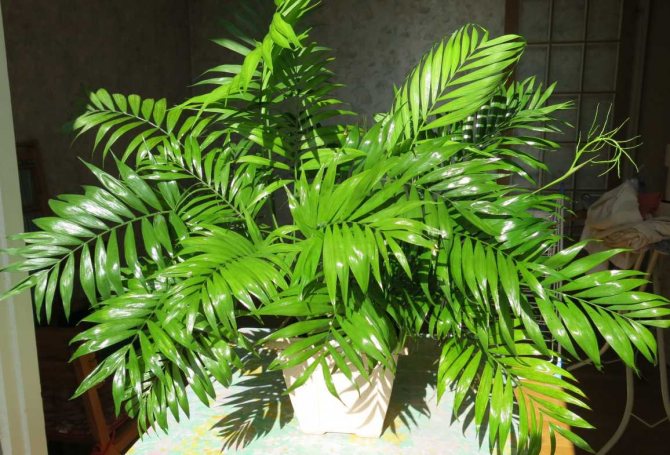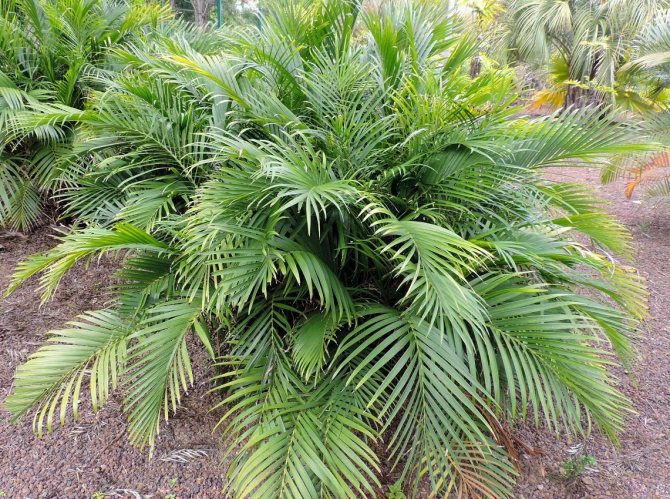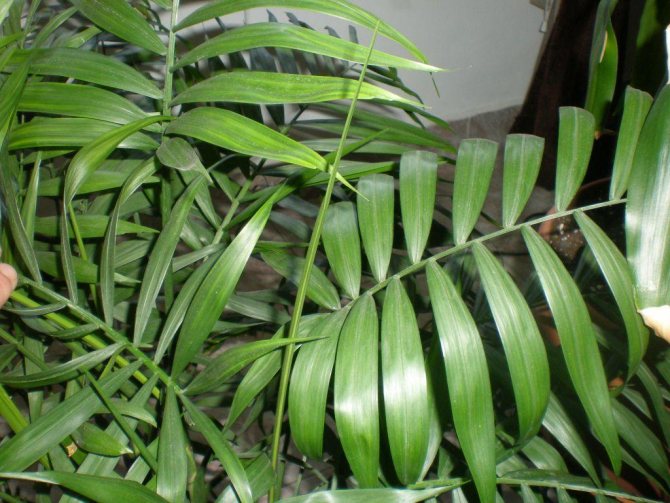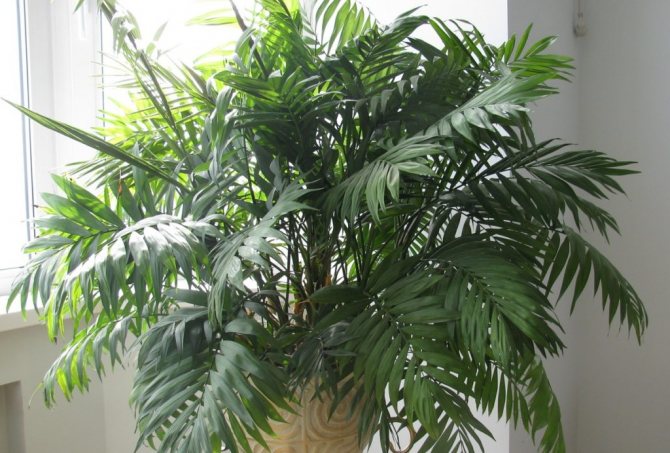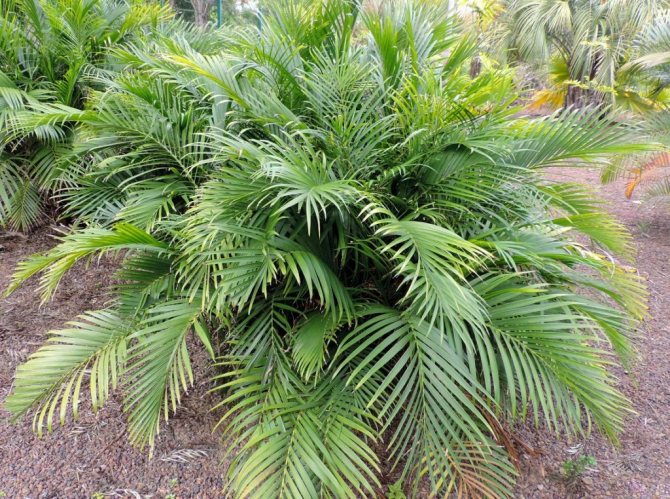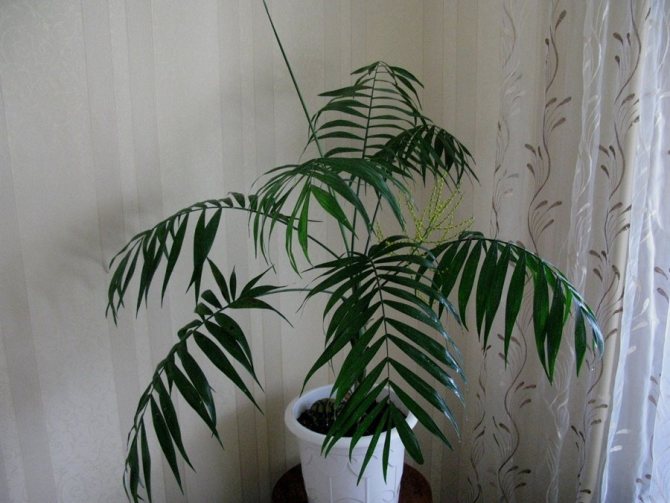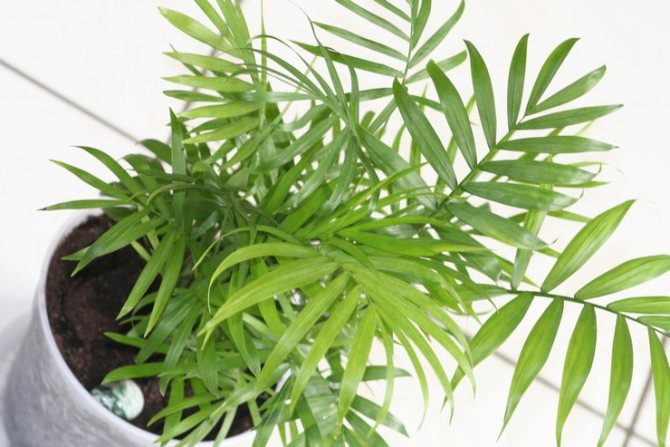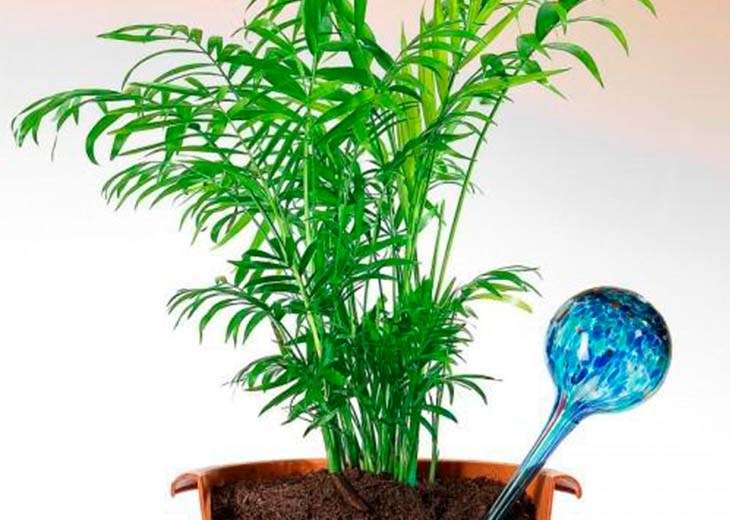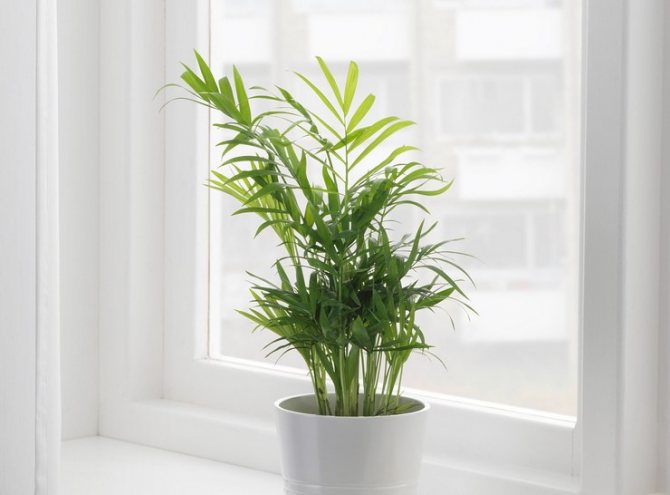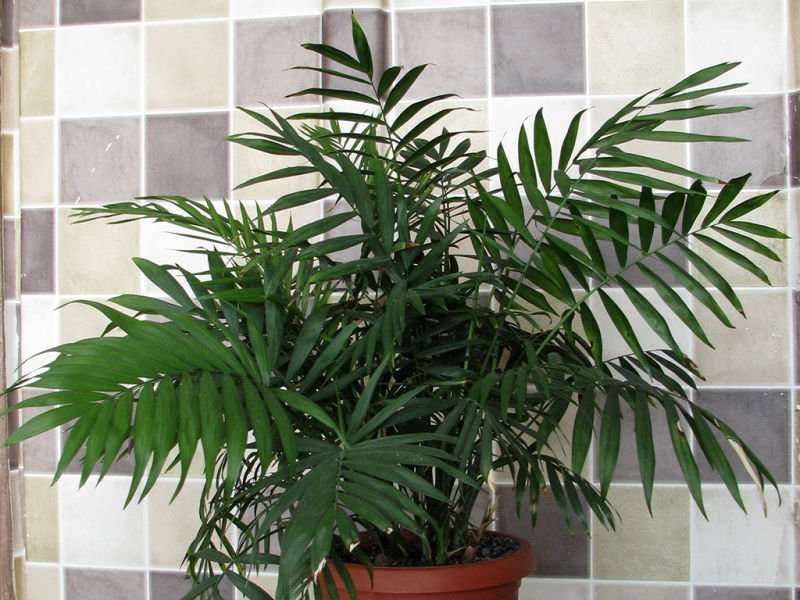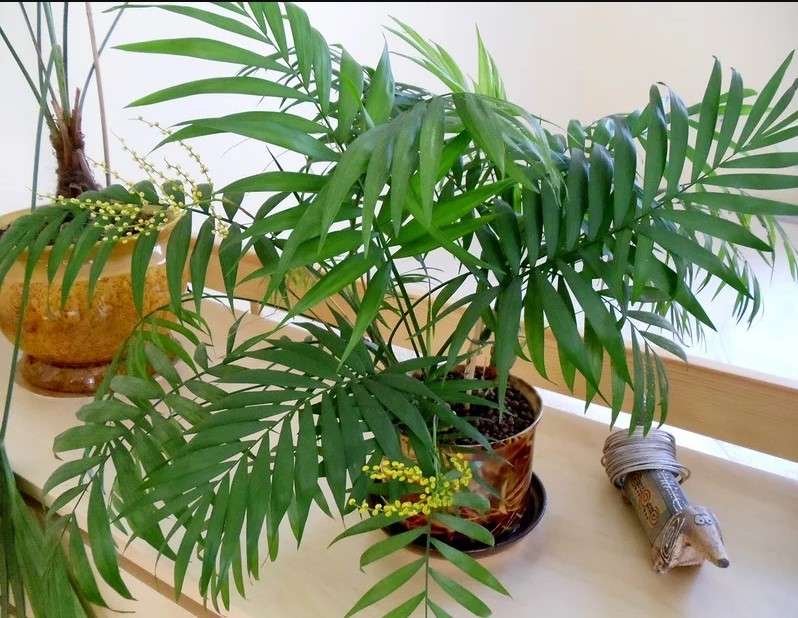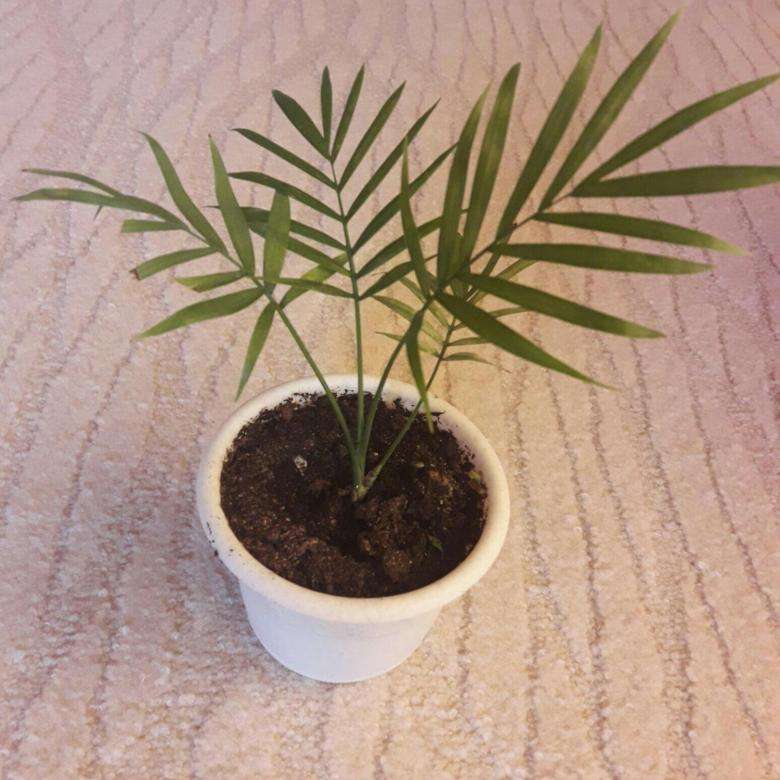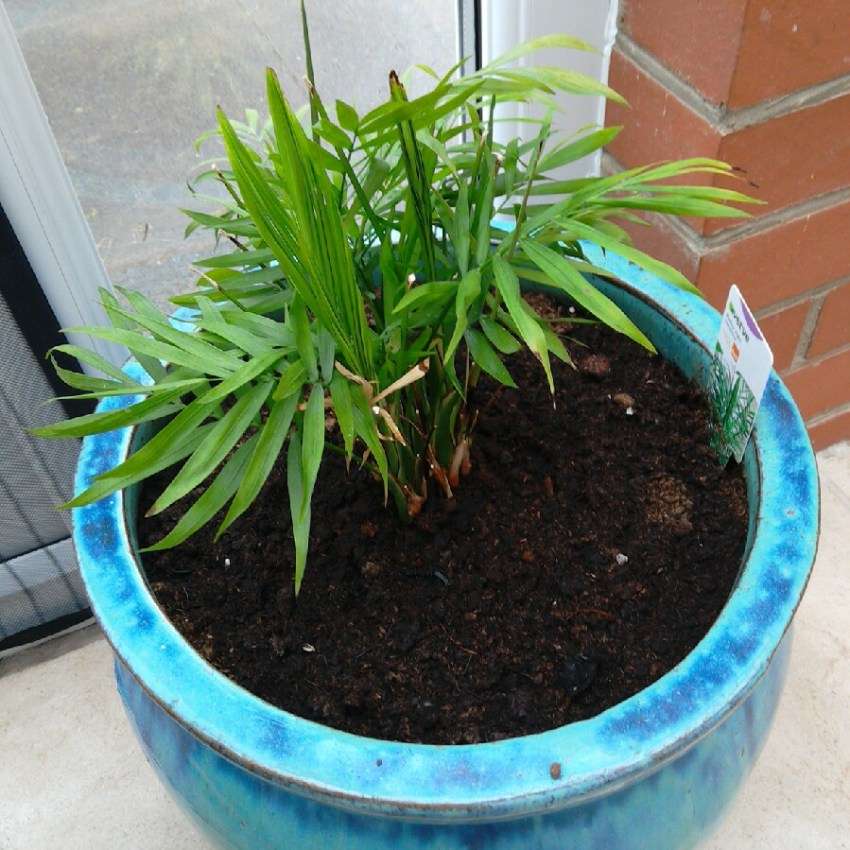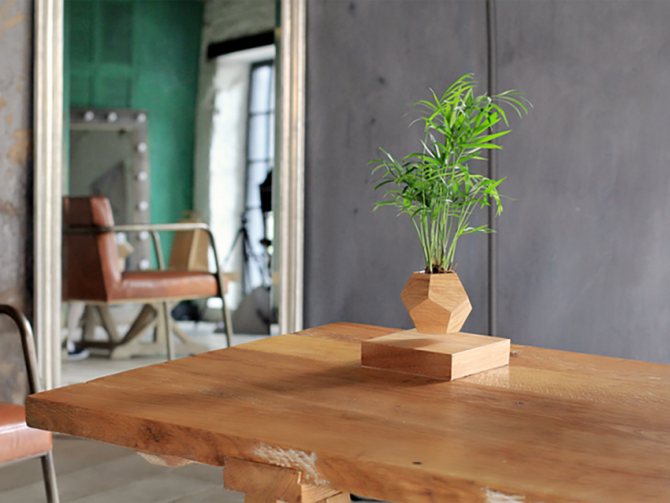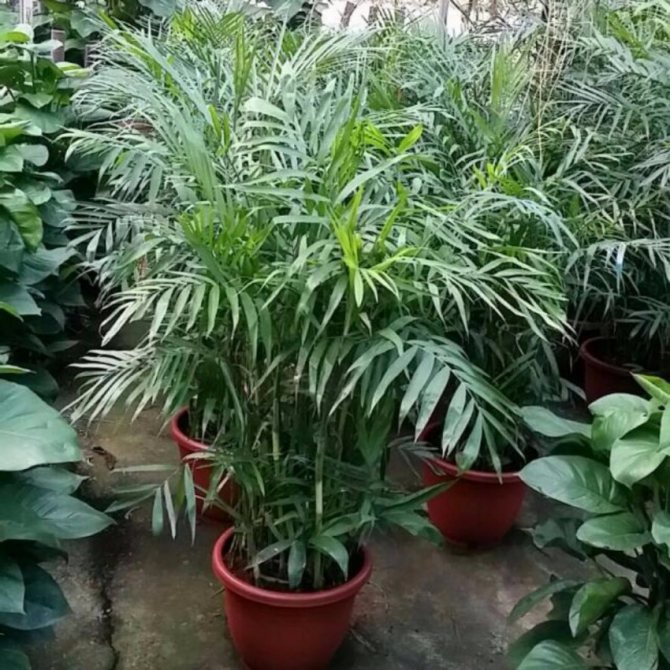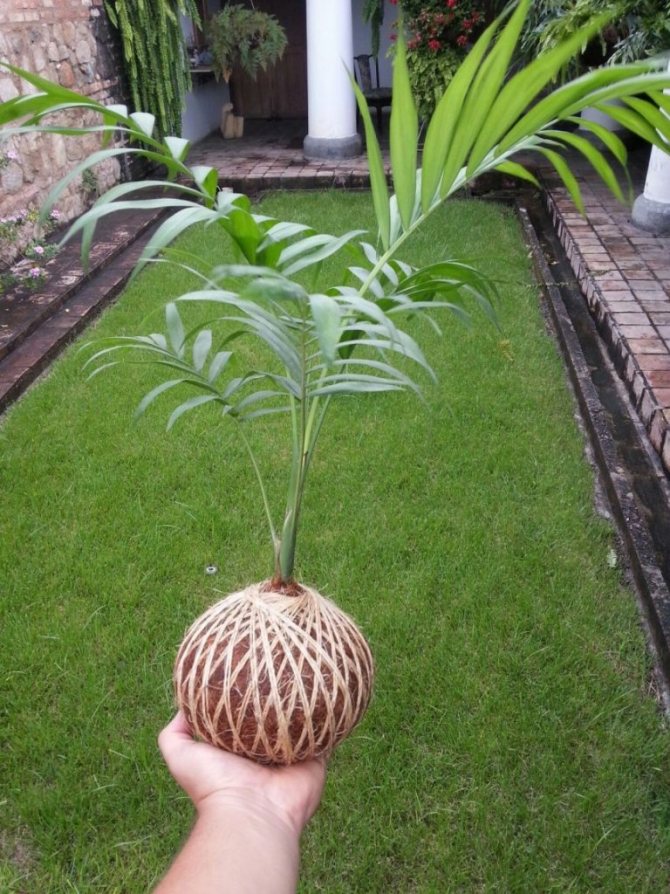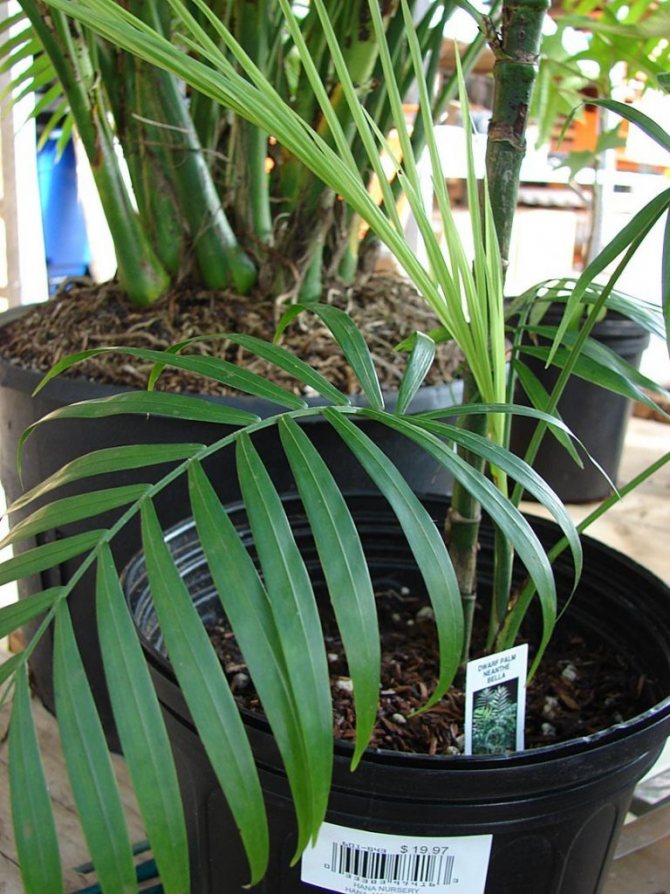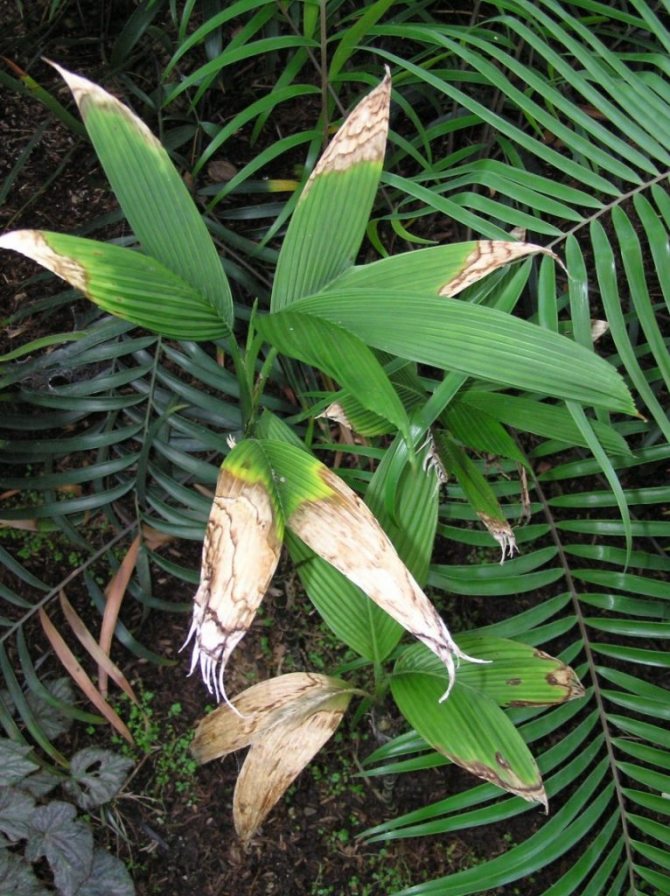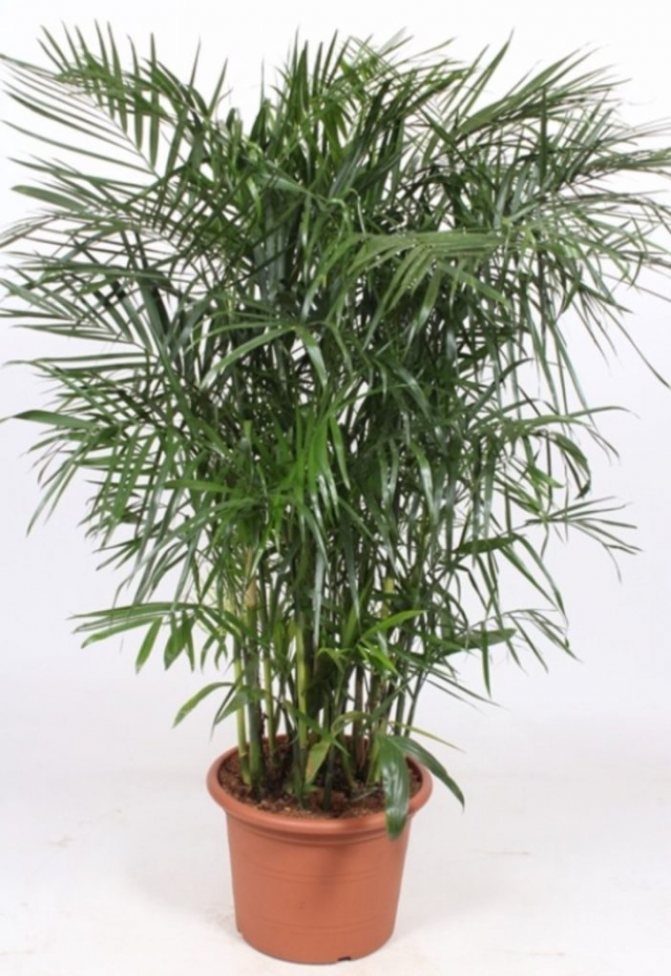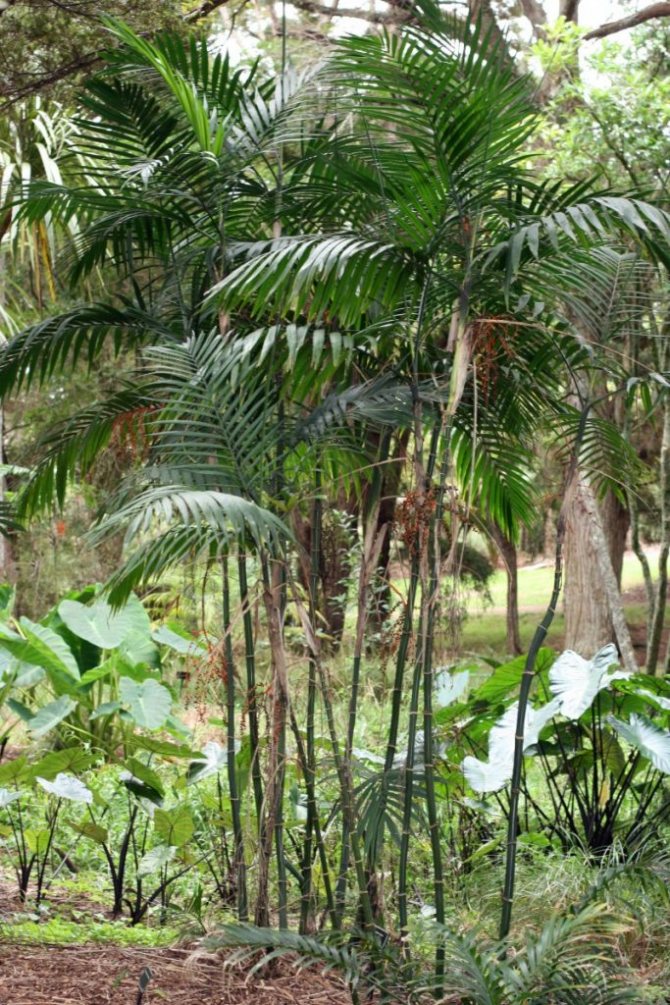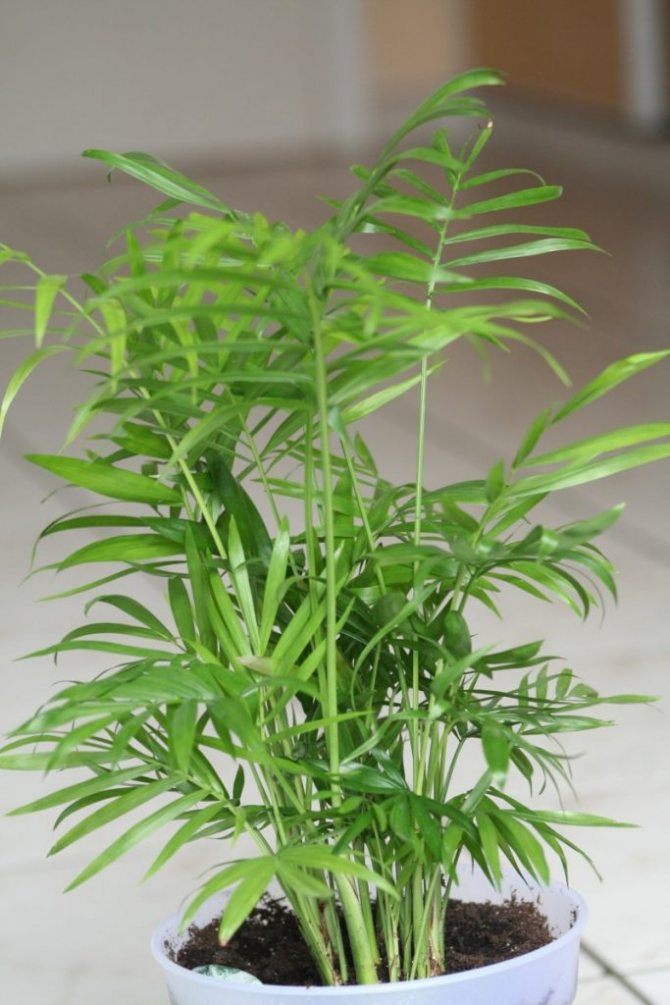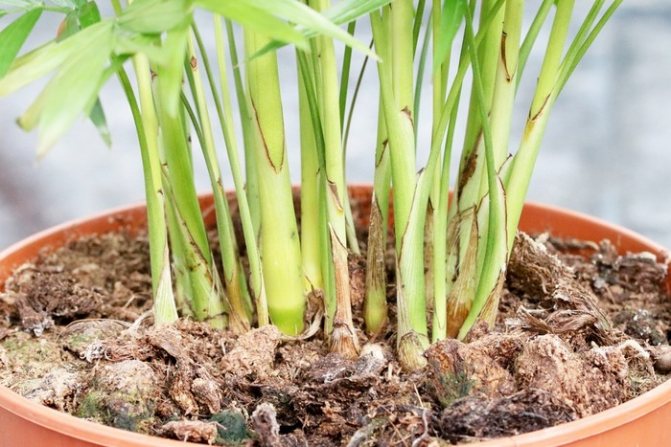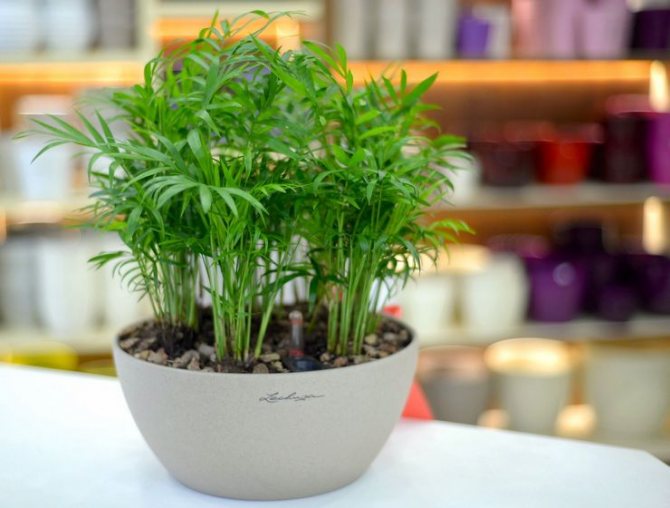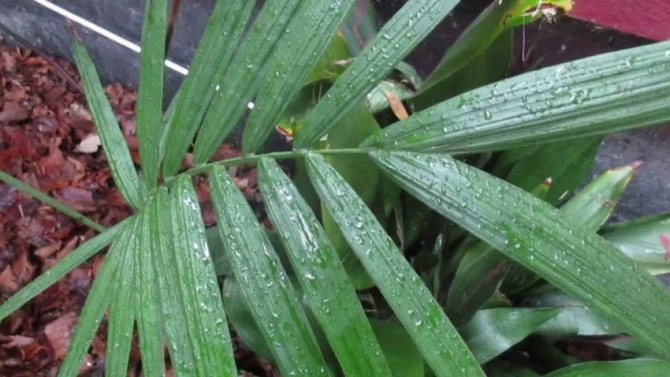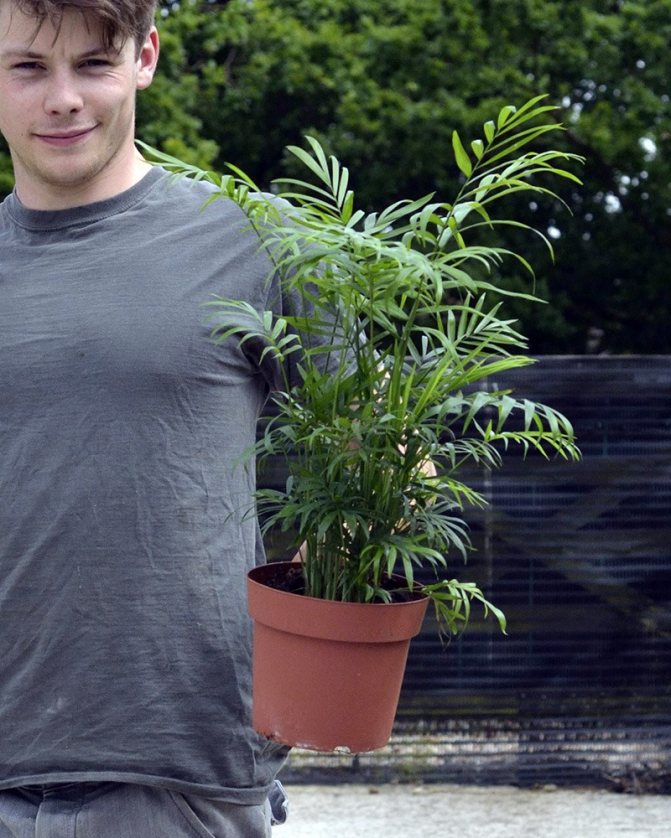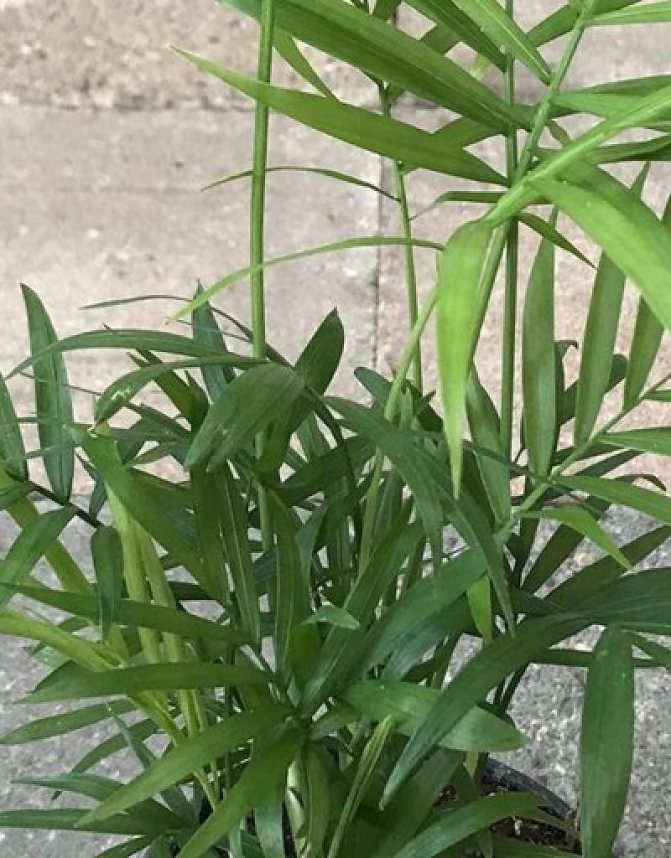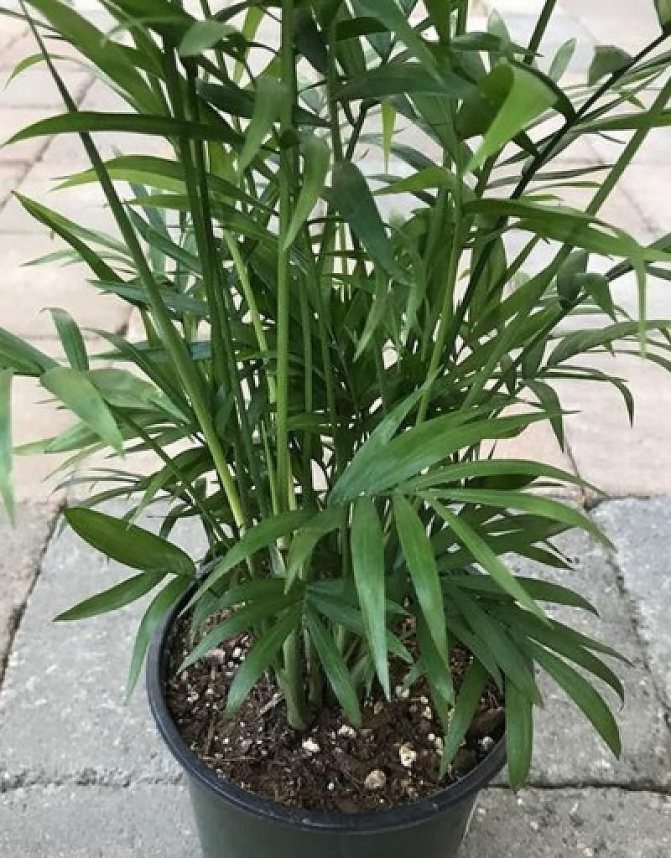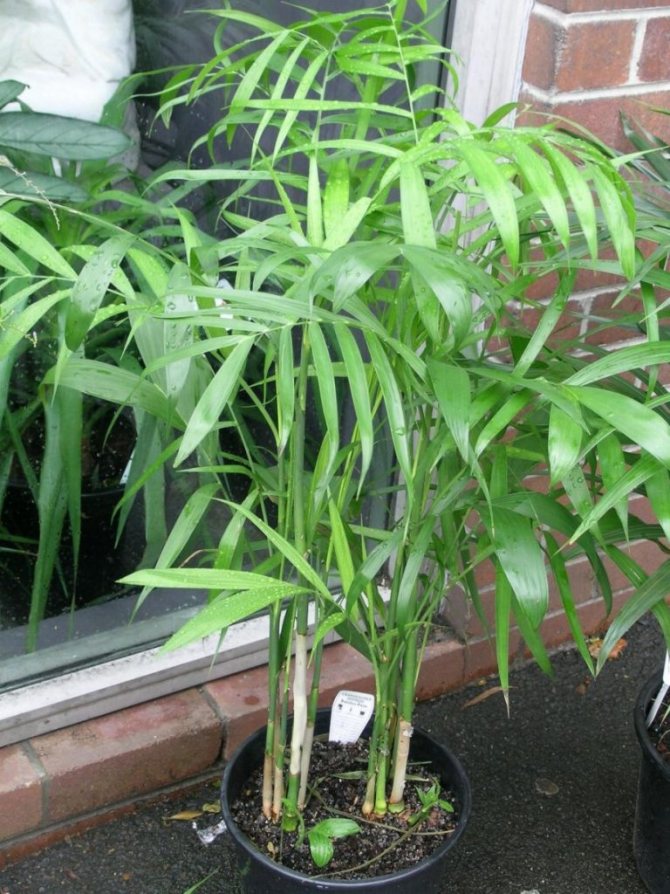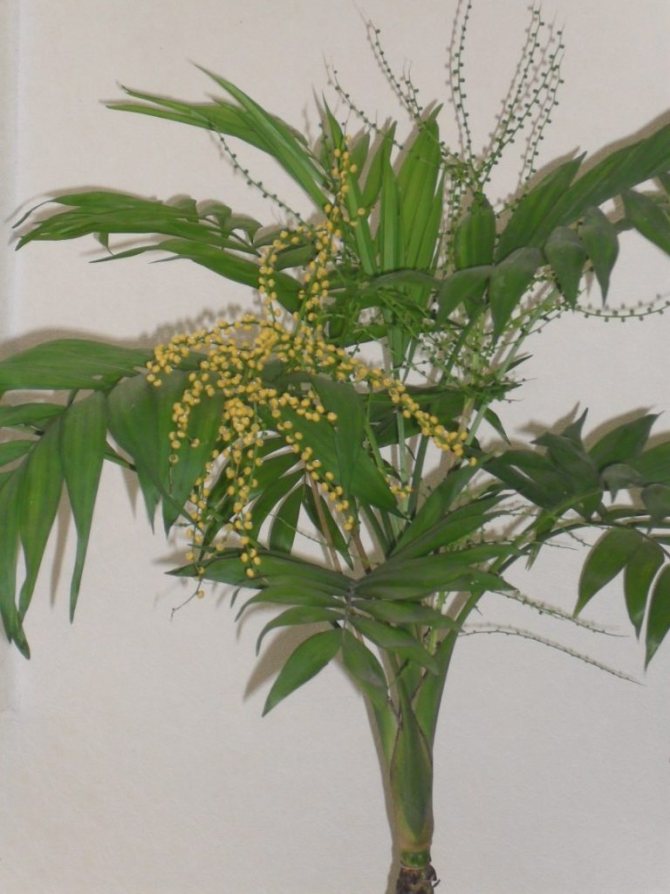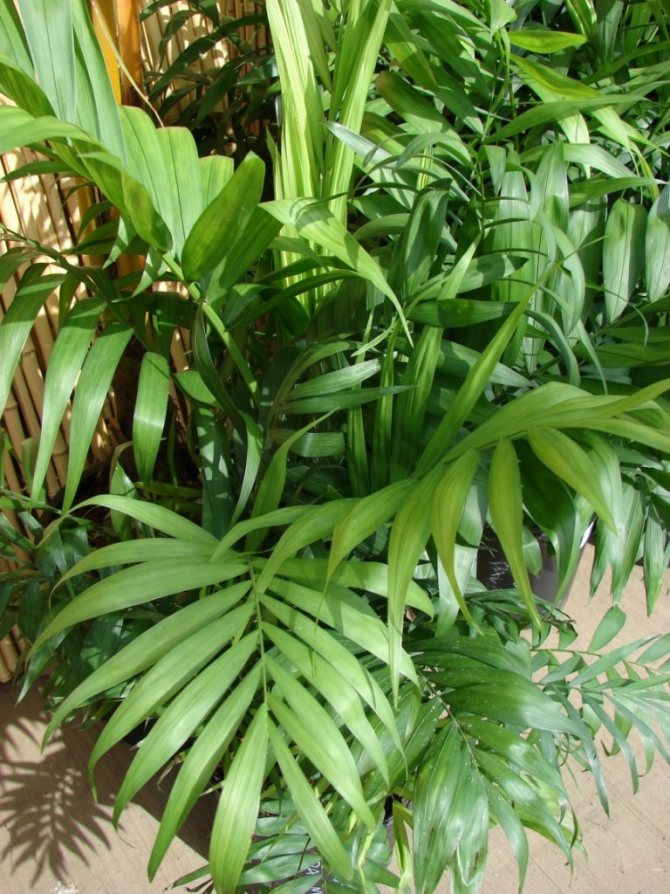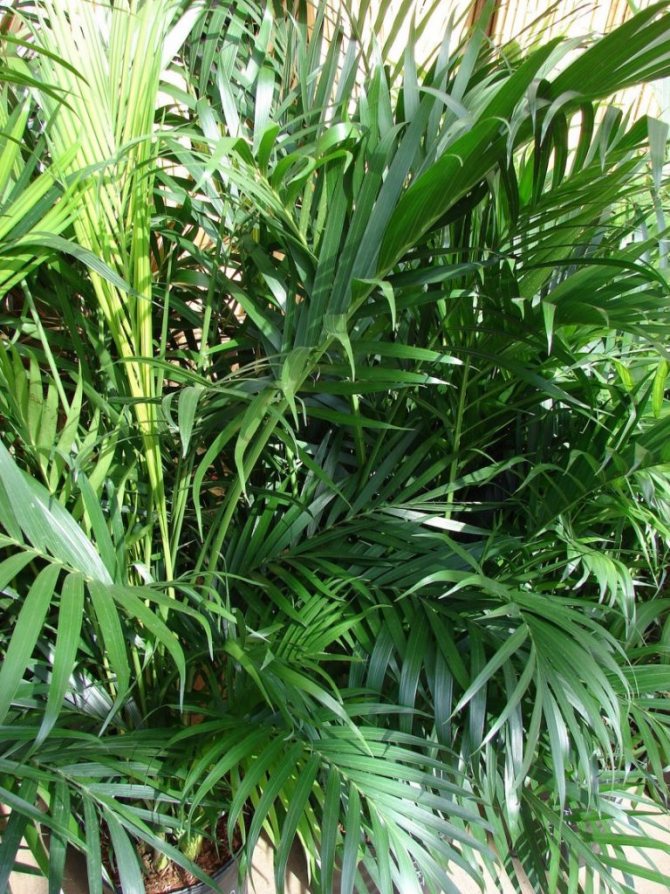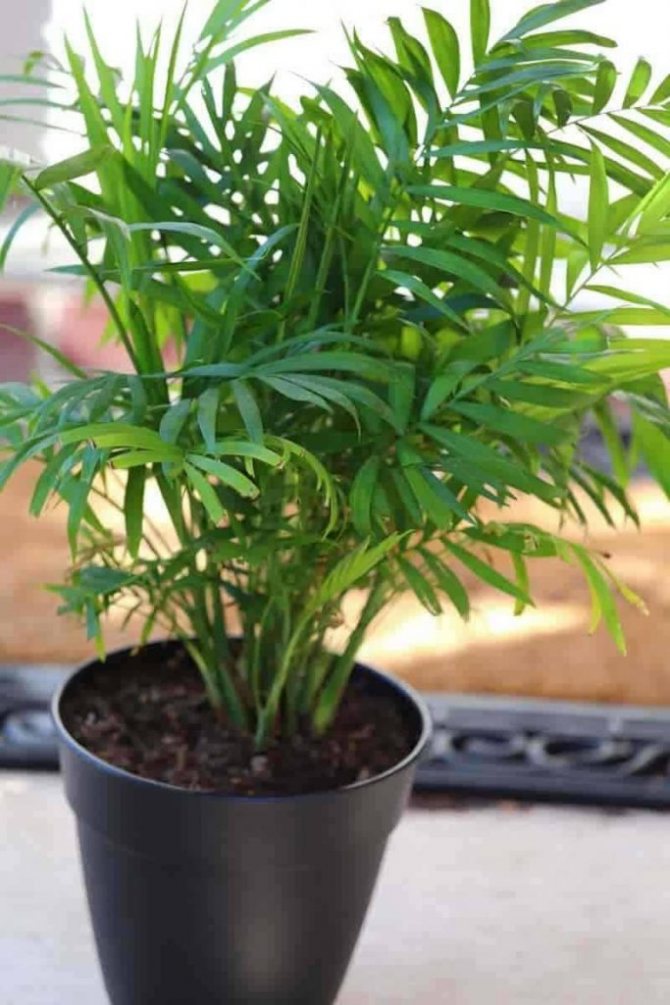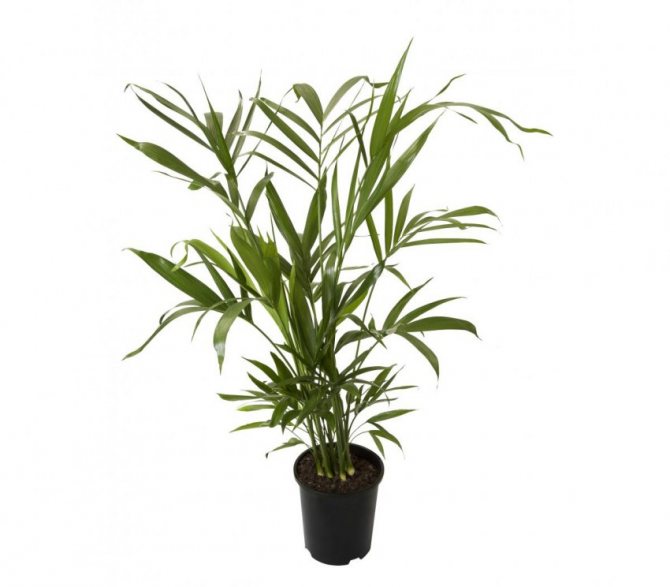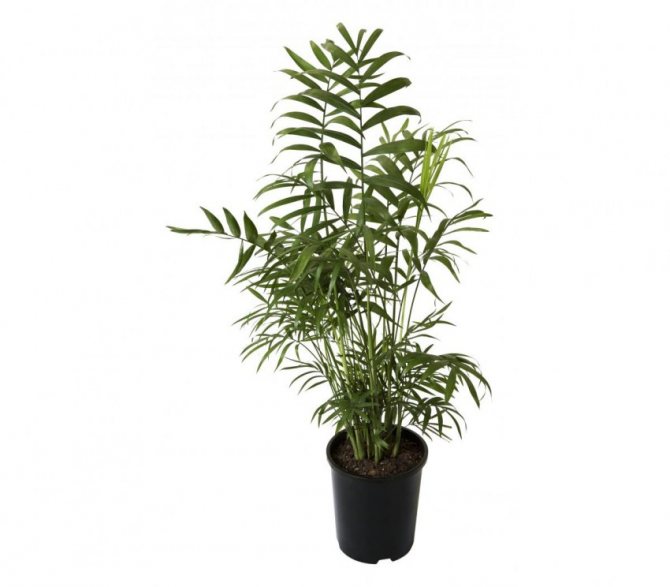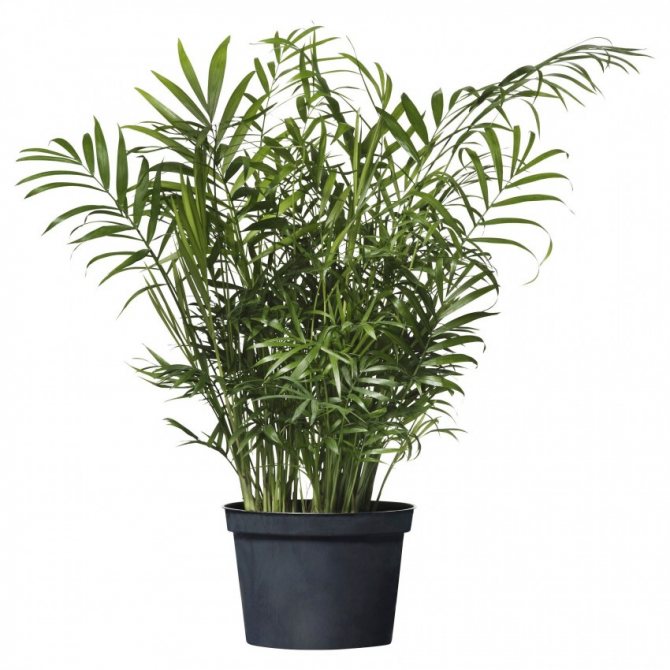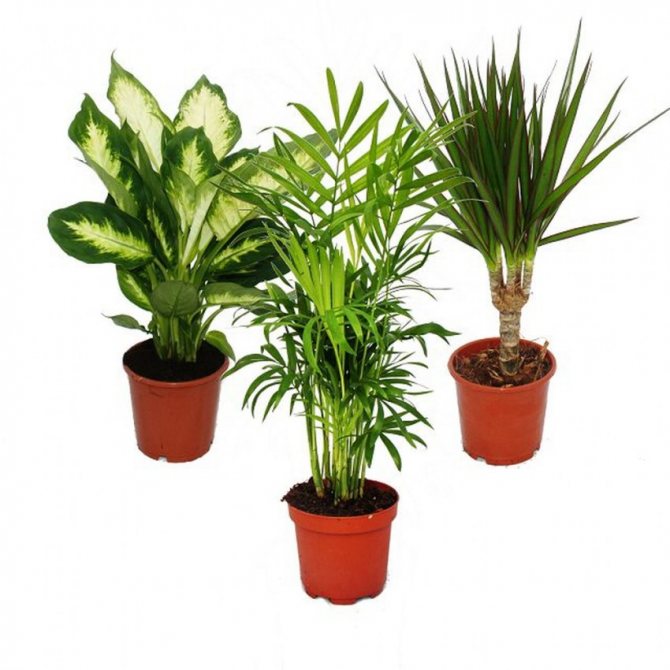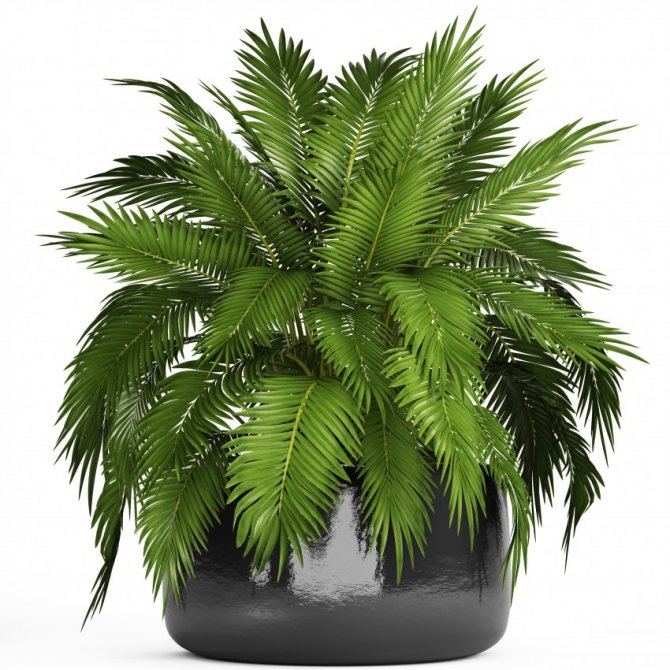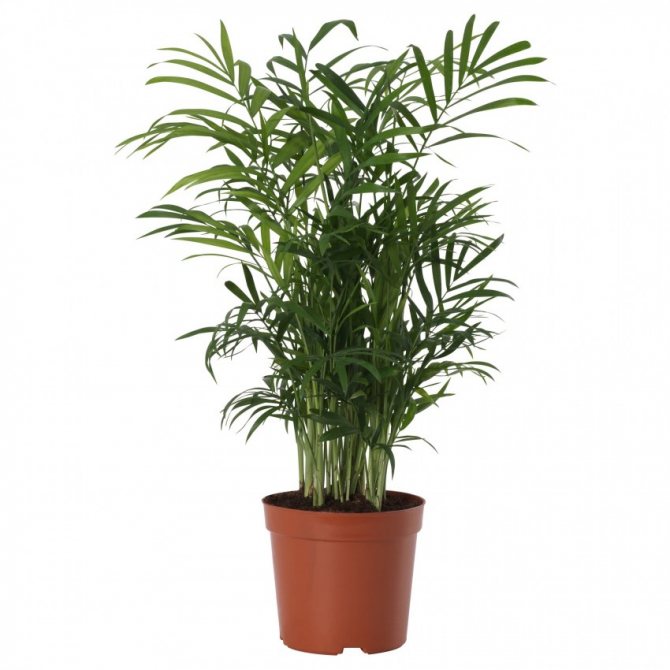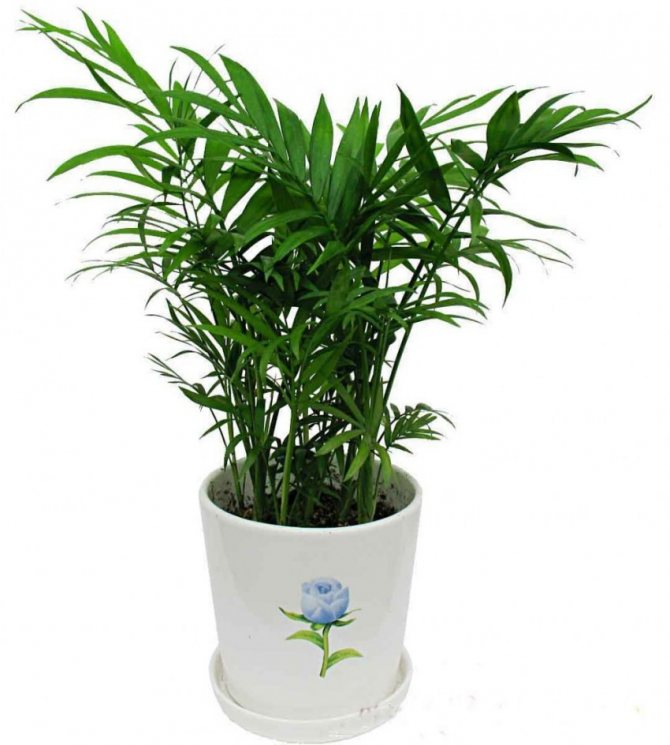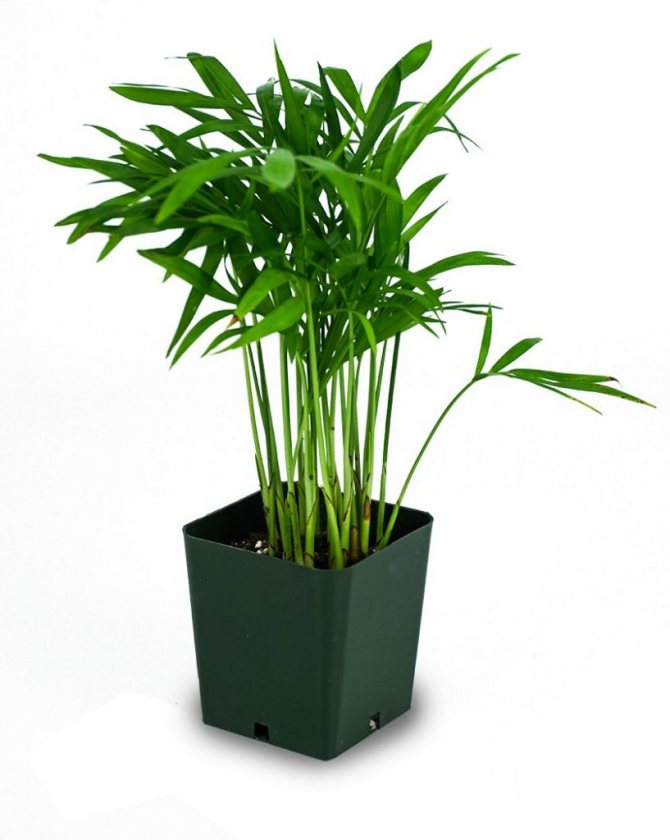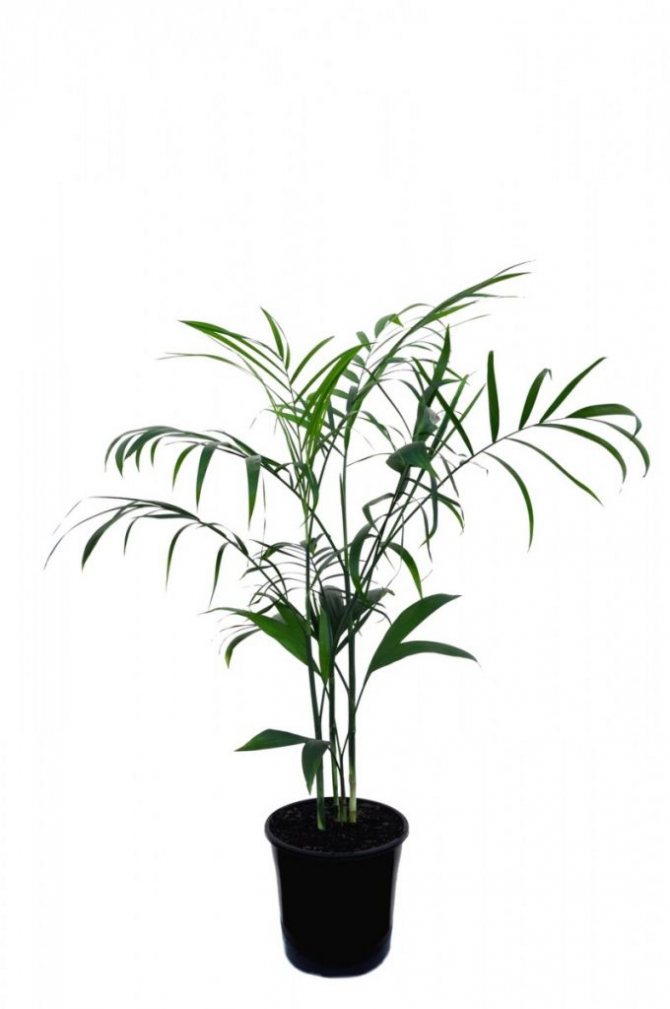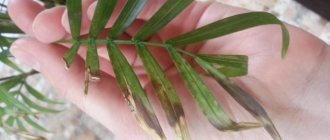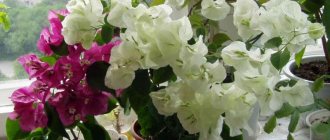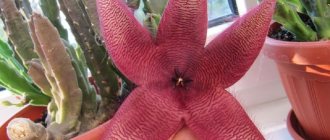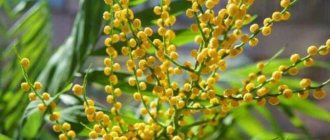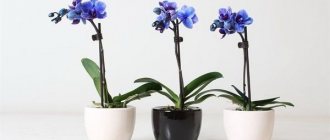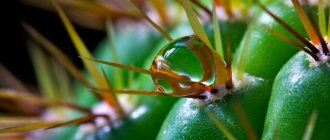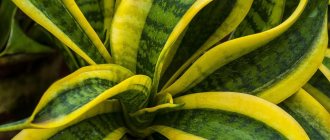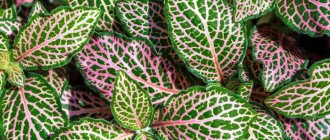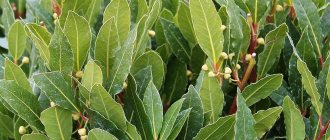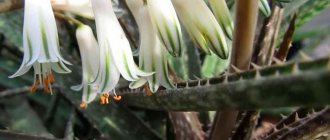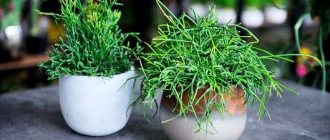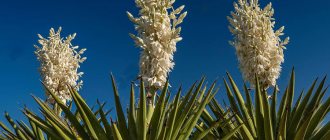The bamboo palm or Chamaedorea is a graceful home-grown palm. Loves shaded areas and is very unpretentious. The plant is native to Central and South America, Mexico. This decorative leafy plant will decorate any room: an apartment, an office, a greenhouse. Since not all types of hamedorea are suitable for indoor breeding, it is worth familiarizing yourself with them and the features of care before purchasing.
This plant can often be obtained as a gift from colleagues, as it looks pleasant and exotic, creating a tropical atmosphere in the house.
Description of hamedorea
At home, the bamboo palm grows very slowly and rarely reaches a height of one and a half meters. Each stem has only one apical bud, which should not be allowed to die. The leaves are whole or dissected from light green to emerald green, there are species with blue-green foliage. Flowers are collected in panicles.
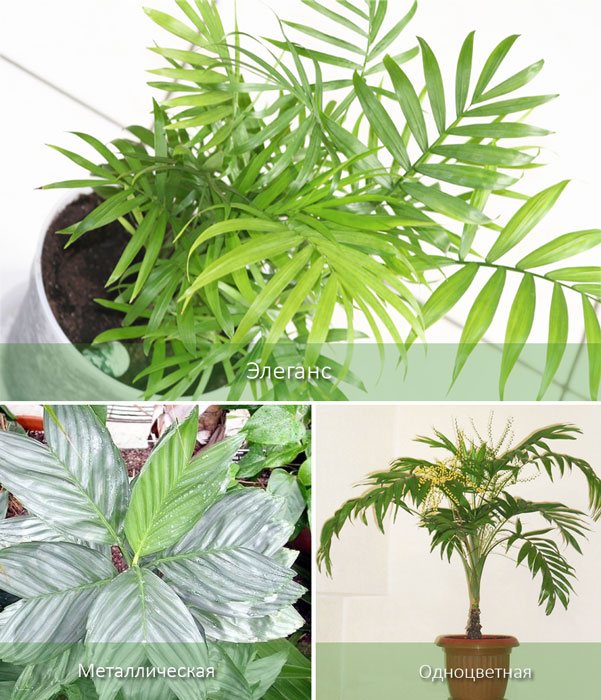
The plant is unpretentious, prefers partial shade to the bright sun, has a small size, decorative foliage serves as an original decoration, helps purify the air.
Types of hamedorei
Traditionally, flower growers recommend choosing one of the following types of plants for the home:
- Chamaedorea Elegans (graceful) is a common home cultivar in the palm family. In a pot, it can grow up to 1.2-2 meters. Often grows in several trunks, their diameter depends on the height of the specimen - in an adult species up to 3 cm. It produces large yellow buds, collected in inflorescences. Up to 7 branches with a lush green mass are formed on each trunk. The length of the pinnate leaf ranges from 40 cm to 1 m.
- Chamaedorea Elatior (high) - it is better to keep it in halls and greenhouses, as it reaches 3-5 meters in height. Each thin stem has up to 6 dark green leaves with a feathery structure. This variety produces panicle-shaped buds.
- Chamaedorea Concolor (monochromatic) is a low-growing variety bred for greenhouses, with medium-sized light green leaves. As it grows, it fills the entire pot, resembling a shrub.
- Chamaedorea Ernesti-Augusti (Ernesta-Augusta) - with a thin trunk and aerial roots, the most demanding microclimate at the place of cultivation. The sheet plastic is one-piece with cuts, resembles a heart in shape. Differs in fast growth and abundant flowering, even in the conditions of cartography. Produces bright scarlet buds.
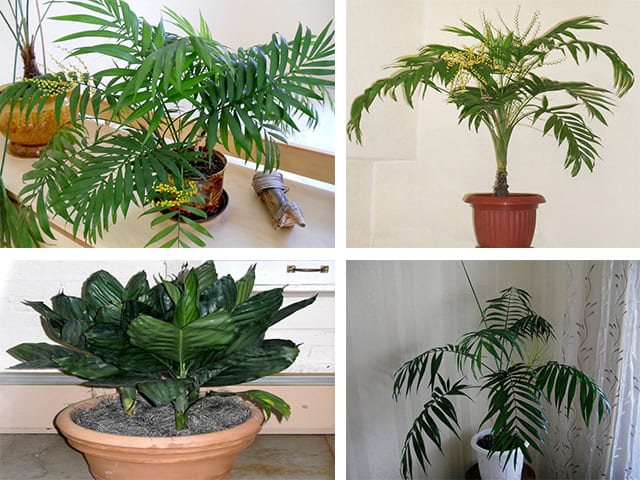

- Chamaedorea Metallica (metallic). Its distinctive feature is the leaves of a dark green hue with a pronounced metallic sheen. It is rare for flower growers at home, more often it is grown in botanical gardens.
- Chamaedorea Stolonifera (stoloniferous) - looks great in the interior, it seems that a lot of bushes have been planted in the pot. The maximum number of shoots is formed from one rhizome. Height up to 1 m, and leaf length up to 20 cm. Produces bright orange buds.
- Chamaedorea Arenbergiana (Arenberg) - has a single trunk with 5-10 leaves, height up to 1.8 m.Differs in narrow leaves. Easily adapts to any conditions, fully artificial lighting.
- Chamaedorea Geonomiformis (geonomiform) - tree-like with a single trunk. The leaves are collected in a panicle located at the top. The leaf plate has a deep dark green color.
- Chamaedorea Erumpens (erupting) - grows up to 1 m, has drooping leaves. Differs in growth at any time of the year, for which it received such a name.
- Chamaedorea Cataractarum (cascading, "cat palm") - miniature with thin, light green leaves. Watering it must be carefully monitored, since it develops only when moisture is sufficient.
- Chamaedorea Bridbl (Bridble) - breeding variety, which is based on an elegant variety. Outwardly, it repeats the parental species, it is distinguished by large fragrant flowers.
- Chamaedorea Seifrizii (Zeifritz) - bushy with leaves on thin petioles. Sensitive to sunlight, which explains the unusual fan-like shape of the leaf.
In flower shops, in order to give the palm an attractive appearance, they offer several seedlings of the same variety in a pot at once. Before buying, study its features. If it is a tree-like species, you need to leave only one shoot, in other cases remove all weak seedlings, leaving from 5 to 7. Thinning should be done a week after purchase, during which time the flower will adapt to new conditions.
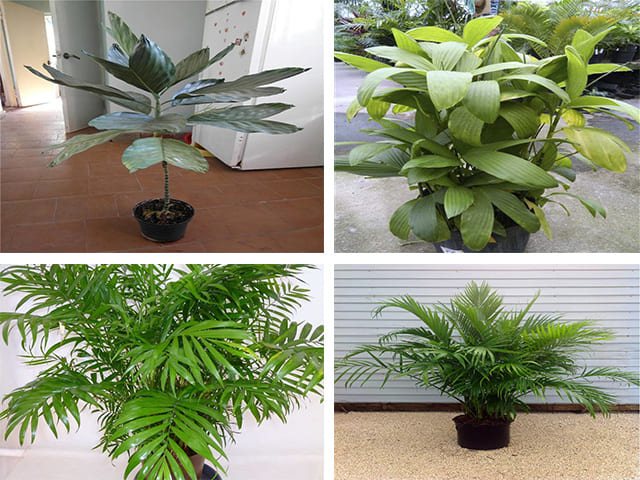

Types of hamedorea for indoor cultivation
| View | Description |
| Hamedorea Elegance (Neanta) | Suitable for beginner florists. The leaves are arranged on long petioles. |
| Seifritz | Not demanding for watering. The stems are like bamboo. |
| Ernest August | The difference of this palm is solid leaves with denticles along the edges. |
| Metal | Beautiful metallic sheen of the leaves. |
| Monochromatic | Green long dissected leaves. |
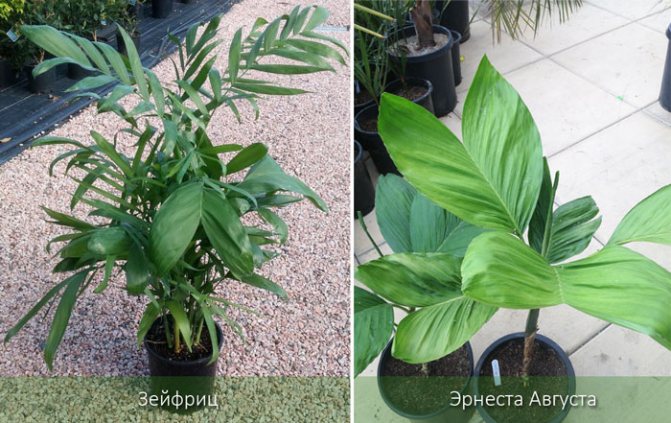

Home care
| Season | Location, temperature and lighting | Humidity and watering | Top dressing |
| Spring | Warm place, + 16 ... + 20 ° C, diffused lighting and partial shade, it is possible to place it near a window. | Watering and spraying once a week. The water should be warm. | Granular fertilizers twice a month. |
| Summer | Can be placed on a balcony or in a garden in partial shade, + 20… + 25 ° C. | Abundant watering and spraying twice a day. | |
| Fall | Warm place, no drafts, + 16… + 22 ° C, partial shade. | Spraying and watering once a week. | Reduce top dressing. |
| Winter | Warm place, no drafts, + 15… + 18 ° C, but not lower than + 12 ° C, diffused lighting. | Spraying and watering is moderate. | Refuse feeding (from October to February). |
The choice of capacity, soil, transplant
The main condition for transplanting chamedorea is the complete filling of the pot with the roots. If this does not happen, you can add some earth to the pot.
It is better to transplant chamedorea in the spring. The pot should be several centimeters higher than the previous one. To prevent the roots from rotting, good drainage is needed (pebbles, expanded clay, tiles). It is good if the pot is stable and made of ceramic.


The soil for the plant should be light. Its composition (2: 1: 2: 2):
- Peat.
- Sand.
- Leafy land.
- Humus.
- Vermiculite, coconut crumb to lighten the soil.
Leafy soil and humus must be disinfected.
Priming
A mixture of soil for chamedorea is commercially available. One has only to go to specialized stores. As a last resort, you can use a universal primer. It is very important to pay attention to the drainage of the flower pot.
Reproduction of hamedorea
There are three ways to propagate a plant.
Seeds
This is one of the longest and most time consuming methods. It is important to observe several conditions: the seeds must be freshly harvested, stratification is necessary (partial destruction of the upper shell of the seed, this can be done with a sharp object) and chamedorea will thank for good care at home.
Pre-soaked palm seeds should be placed in plastic two-hundred-gram containers with nutritious soil, slightly deepening (1-2 centimeters), it is not required to sprinkle it with earth, it is necessary to cover it with glass or film.
It is required to ensure that the earth does not dry out.Remove glass or foil daily for air access.
After 5-6 months, chamedorea will give the first shoots, which must be planted as they grow.
Dividing the bush
Well-grown adult chamedorea plants are suitable for this method. You need to gently get the palm tree out of the pot, untwist the roots. For separation, processes with three or four well-developed roots are suitable. Plant them in 5-6 pieces in one pot, cover with foil, providing a comfortable environment. Do not forget about watering and spraying.
Propagation by basal processes
A well-developed adult plant is suitable for this method. Carefully separate the shoot with formed roots from the mother plant, move it to a pot with good drainage and nutritious soil, cover with foil, leave in a warm, bright place, ensuring timely watering. It is better to do this in early spring.


Comfortable air temperature for hamedorea
The palm tree develops wonderfully without losing its decorative effect at the usual room temperature for a person, it is about 16-20 degrees. The only thing is that in winter he needs to provide a temperature regime of about 12-15 degrees.
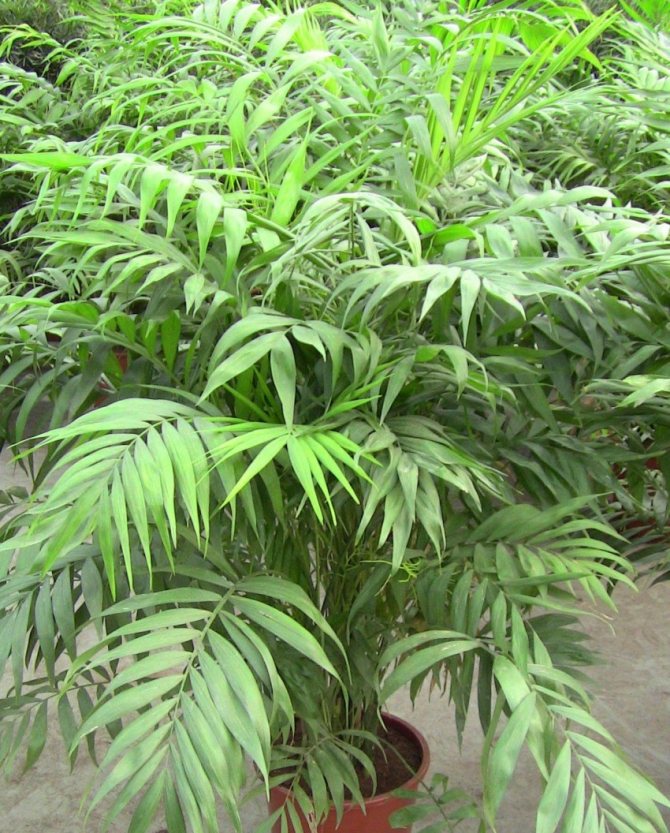

A smooth decrease in the room temperature even to 10 degrees will not adversely affect hamedorea. She is afraid of sudden changes in temperature.
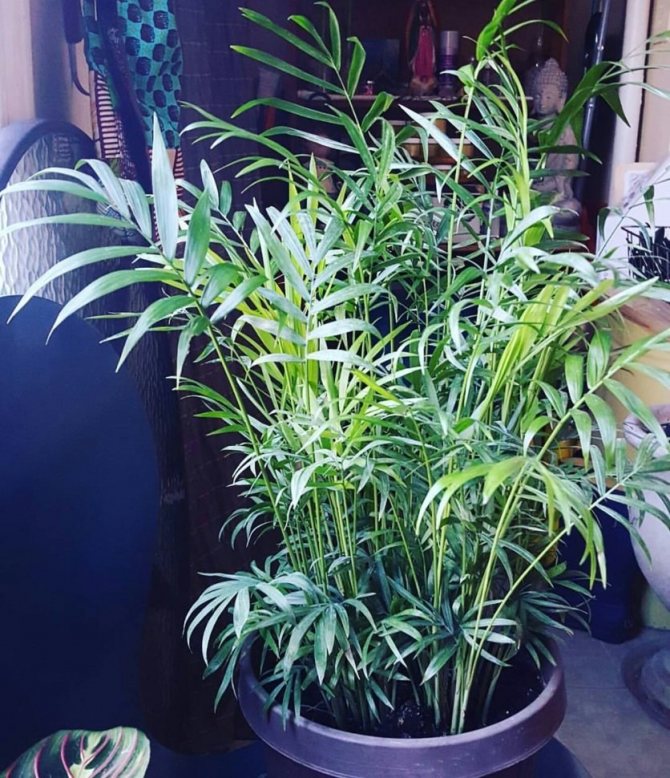

In order for the plant to continue to delight for a long time, it is imperative to air the room on a regular basis.
Care errors and their elimination
Hamedorea is unpretentious and easy to care for; even a novice florist can grow it. If you follow the rules for growing it at home and take preventive measures in a timely manner, then many problems can be avoided.
| Visible damage | The reasons | Elimination |
| The tips of the leaves dry up. | Insufficient watering or hard water. | Water only with soft water, increase its volume. |
| The appearance of light spots on the leaves. | Lack of trace elements. | Add magnesium and potassium to the water. |
| Small foliage. | Lack of light and fertilizer. | Move to a bright place, add fertilizer to the water. |
| The color of the leaves is light yellow. | Direct sunlight, lack of iron. | Move the palm tree to a shaded place, water with fertilizers containing iron. |
When and how it blooms
Chamedorea flower - leaves dry, what to do
Hamedorea graceful sometimes blooms, and its inflorescences resemble a mimosa branch.
During the flowering period, the plant knocks out a peduncle from the leaf axils - it bears a loose and branched panicle with small inflorescences, yellow, spherical flowers. After the end of flowering, in place of the flower, a round fruit, black, is formed, in which there is one seed.
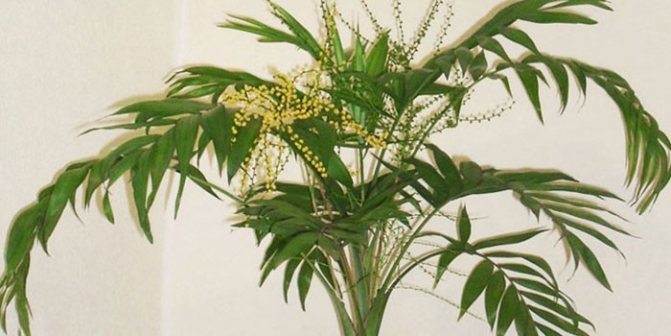

a palm tree blooms like a mimosa
The flowers are small and spherical, light yellowish in color. They do not represent any particular decorative value and in appearance resemble a mimosa branch.
The flowering of this type of palm is not tied to the season and a specific period. If favorable conditions are created, the palm tree can bloom in spring and autumn.
Changes in care during flowering
In this case, there are no special changes in care, the only thing is that palm owners should water it more often, apply a subcortex every 7-10 days.
At the same time, spraying at the time of flowering is stopped - they just put a container with water next to it and that's it.
Diseases and pests, the fight against them
Diseases and pests weaken the plant, interfere with normal growth, and reduce decorativeness. Therefore, it is necessary to carry out preventive measures, and in case of a developed disease, immediately take measures to eliminate it.
| Disease / pest | Symptoms (on leaves) | Prevention and treatment |
| Spider mite. | Web. | Spray more often. In case of severe damage, use acaricides and insectoacaricides. |
| Mealybug. | Sticky discharge, they themselves are pale green. | Wash off pests with water from the addition of soap, in severe cases, treat chamedorea with Vertimek. |
| Thrips. | Black drops. | Use insecticides Aktara and Confidor. |
| Root rot. | Fall off. | Transplant the plant. Water with Khomecin and Kuprozan solutions for 10 days. |
| Rot of the stems. | White bloom. | Destroy the plant and the pot if heavily infested. |
How hamedorea elegance multiplies
Propagated by seeds, cuttings and by rooting the cuttings.
- Germinating seeds
Rosemary - home growing and care
The seeds are sown in special greenhouses, where the temperature is maintained at 25-27 degrees - the first shoots appear after 30-40 days.
The very process of seed germination can take up to six months - all this time, the soil is sprayed, and fertilizers are applied in the same way once a month. When shoots appear, the care is the same as for an adult plant.
Important! When 5-6 true leaves appear, they are transplanted into a separate container.
- Rooting cuttings
Take strong, healthy cuttings, carefully cut with a sharp pruner. The planting material is placed separately in an individual container. Care as for an adult plant. After the plant gets stronger, it is planted in a permanent place, in a prepared container.
- Air layering
The main thing in this case is not to break off the layers - they are carefully cut off with a sharp knife, then planted in peat soil with the addition of sand. It is in such a soil that the rooting of the cuttings takes place - in time it takes 4-5 months, after the plant is seated in separate flowerpots.
Transfer
The plant does not like a large number of transplants. A young plant is transplanted as the roots encircle the earthy clod - on average, once a year. Moreover, adult plants are transplanted every 3-4 years, choosing a flowerpot 2-3 cm larger than the previous one in diameter.
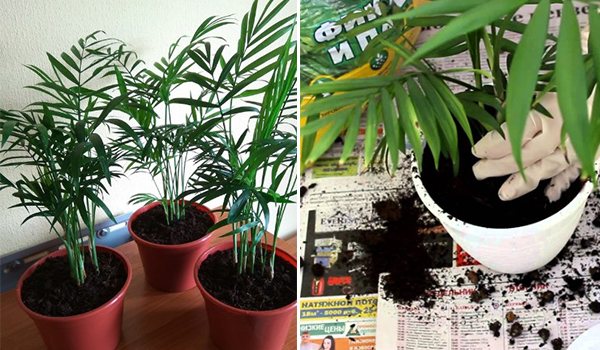

correct transplant is the key to abundant growth
Mr. Dachnik recommends: hamedorea - a charge of cheerfulness and optimism
The bamboo palm is a beautiful and elegant plant, with careful and attentive care, it can harmonize the environment, delight with graceful foliage, while making the air in the house cleaner.
According to popular beliefs, it is believed that hamedorea eliminates negative energy in the house. Where it is located, unfriendly people do not linger, there is less noise and fuss. The palm tree promotes concentration, improves mood and vitality.
In the room where chamedorea grows, it is easy to breathe, it works fruitfully. If there are these bamboo palms in the house or office, then all the work started will be completed on time.
Problems with hamedorea
- Yellowed leaves. With this problem, you should pay attention to 3 points: insufficient watering, low humidity in the room and an unnecessarily low air temperature.
- Dry leaves. This problem has 2 reasons: too cold and too little moisture in the air. It must be corrected, otherwise the plant will wither.
- Rotting roots. Excessive watering and cooling can lead to root rot. Transplant by draining and warm the palm.
- The dying off of the lower leaves is a natural process. You don't need to pay attention to it. It is only necessary to remove the dried parts of the plant during the pruning process, closer to the trunk.
- Drying of leaves - excessively dry air in the room.
- Small brownish spots on the leaves indicate that the palm is watered in the sun.
- Drying cones of leaves indicate excessive watering.
Hamedorea is a plant with which a folk omen is associated - if the plant is brought into the house, then trouble will happen. To believe or not to believe in omens is the business of every person. But in order to protect themselves from this misfortune, people simply bring a pot in a chamedorea flower into their house and everything is in order, the trouble bypasses the house.
Therefore, to the question of whether it is possible to keep chamedorea at home and whether it is worth paying attention to the signs, there is only one answer - you can!

